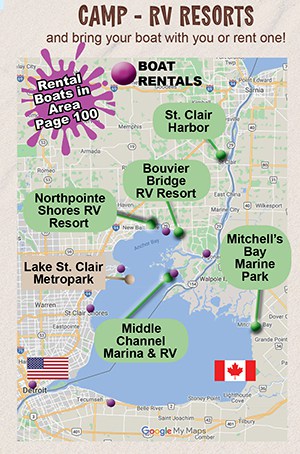Regional Report on Sustainable Development Goal Progress and Challenges
A. Daily Environmental and Infrastructure Overview
- Meteorological Conditions: Partly sunny with potential for morning fog. Highs in the mid-80s.
- Transportation Infrastructure Status: No major commute delays reported. Planned weekend closure of southbound I-75 between Schaefer and Springwells for maintenance, impacting traffic flow and highlighting the ongoing need for infrastructure upkeep (SDG 9).
Waste Management and Urban Sustainability in Macomb Township
Service Deficiencies and Community Impact
Macomb Township has issued a formal notice of default to its contractor, Priority Waste, following significant failures in municipal waste collection services. These failures present a direct challenge to achieving key urban sustainability targets.
Reported Issues and Alignment with Sustainable Development Goals (SDGs)
- Inconsistent Collection: Residents report repeated missed collections, leading to overflowing bins and waste remaining on curbs for extended periods. This contravenes SDG 11 (Sustainable Cities and Communities), specifically Target 11.6, which focuses on the effective management of municipal waste.
- Improper Recycling Practices: There are reports of recyclable materials being mixed with general garbage during collection. This practice undermines efforts toward SDG 12 (Responsible Consumption and Production), particularly Target 12.5, which aims to substantially reduce waste generation through recycling.
- Environmental and Health Concerns: The accumulation of garbage has resulted in unpleasant odors and visual blight, impacting resident well-being and the local environment, a concern related to SDG 3 (Good Health and Well-being).
Corporate Response
Priority Waste has attributed the service disruptions to extreme weather conditions, including high heat indexes that affect working conditions (SDG 8) and a recent tornado. The company has stated its intention to resolve all service delays by the end of the week.
Infrastructure Deficiencies and Urban Resilience in Detroit
Prolonged Road Disrepair and Economic Consequences
A nearly one-mile section of Mount Elliott on Detroit’s east side has been in a state of severe disrepair for over two years, characterized by numerous large potholes. This situation highlights critical challenges in maintaining resilient and sustainable urban infrastructure.
Impact on Community and Local Economy
- Economic Disruption: Local businesses, such as Hawk Auto Sales, report that the hazardous road conditions have negatively impacted their operations. This undermines SDG 9 (Industry, Innovation and Infrastructure) and SDG 11 (Sustainable Cities and Communities) by impeding local economic activity.
- Transportation Safety: The road’s condition creates a hazardous environment for drivers, failing to meet the objective of SDG 11.2 to provide access to safe, affordable, and sustainable transport systems for all.
Municipal Response and Long-Term Vision
City officials have acknowledged the issue and announced a full reconstruction project. The city engineer stated the new road will be designed to last for 50 years, demonstrating a commitment to building resilient and sustainable infrastructure in alignment with SDG 9.1.
Fostering Local Economy and Community Cohesion through Cultural Events
Blue Water Fest as a Driver for Sustainable Growth
The annual Blue Water Fest in Port Huron serves as a model for leveraging cultural events to support local economic growth and community well-being, directly contributing to several Sustainable Development Goals.
Contributions to Sustainable Development
- Economic Stimulation (SDG 8): The festival, which draws tens of thousands of visitors, significantly increases foot traffic and revenue for local small businesses, such as Local Elite Treats. This supports SDG 8 (Decent Work and Economic Growth) by promoting tourism and supporting local enterprises.
- Community and Culture (SDG 11): By offering a wide range of activities including live music, food trucks, and vendors, the event strengthens community bonds and enhances the city’s cultural vibrancy. This aligns with SDG 11.4, which aims to strengthen efforts to protect and safeguard the world’s cultural heritage and create inclusive community spaces.
Analysis of Sustainable Development Goals (SDGs) in the Article
1. Which SDGs are addressed or connected to the issues highlighted in the article?
-
SDG 8: Decent Work and Economic Growth
This goal is connected to the Blue Water Fest event in Port Huron. The article highlights how the festival boosts the local economy by increasing foot traffic for small businesses, which supports job creation and local economic vitality.
-
SDG 9: Industry, Innovation and Infrastructure
This goal is directly addressed in the section about the road construction on Detroit’s east side. The article discusses the poor state of road infrastructure (“riddled with potholes”) and the city’s long-term plan to reconstruct the road to be more resilient (“last for the next 50 years”), which is central to developing quality and reliable infrastructure.
-
SDG 11: Sustainable Cities and Communities
This is a central SDG in the article. It is addressed through the issues of municipal waste management in Macomb Township (“inconsistent trash collection,” “overflowing bins”) and the quality of urban infrastructure in Detroit. It also relates to the Blue Water Fest, which promotes local culture and strengthens community engagement.
-
SDG 12: Responsible Consumption and Production
This goal is relevant to the waste collection problems in Macomb Township. Specifically, the resident’s complaint about the garbage collector mixing recycling with regular garbage (“puts it all together”) points to a failure in sustainable waste management practices, which undermines recycling efforts.
2. What specific targets under those SDGs can be identified based on the article’s content?
-
Target 8.9: “By 2030, devise and implement policies to promote sustainable tourism that creates jobs and promotes local culture and products.”
The Blue Water Fest in Port Huron is an example of an event that promotes local culture and products. The article states that the festival draws “tens of thousands of people” and that small businesses “have also been planning for a while, as foot traffic increases around this time,” directly linking the event to local economic benefits and the promotion of local culture.
-
Target 9.1: “Develop quality, reliable, sustainable and resilient infrastructure… to support economic development and human well-being.”
The story about the road on Detroit’s east side directly relates to this target. The road is described as a “traffic nightmare” that is “riddled with potholes,” indicating a lack of quality and reliable infrastructure. The city engineer’s promise that the reconstruction will create something that “is gonna last for the next 50 years” speaks to the goal of building sustainable and resilient infrastructure.
-
Target 11.6: “By 2030, reduce the adverse per capita environmental impact of cities, including by paying special attention to… municipal and other waste management.”
The situation in Macomb Township, with “numerous complaints from residents about inconsistent trash collection service,” “overflowing bins,” and garbage “sitting out for days,” is a clear issue of municipal waste management. The resulting smell (“Then it starts to smell”) is an adverse environmental impact on the city’s residents.
-
Target 12.5: “By 2030, substantially reduce waste generation through prevention, reduction, recycling and reuse.”
This target is implicated by the resident’s complaint that “the garbage man picks up both the recycle and the garbage at the same time, puts it all together.” This action directly contradicts the goal of promoting recycling as a means to reduce waste, indicating a systemic failure in the waste management process.
3. Are there any indicators mentioned or implied in the article that can be used to measure progress towards the identified targets?
-
For Target 9.1 (Infrastructure):
- Indicator: Quality of road infrastructure. The article provides a qualitative indicator by describing the road as “riddled with potholes that appear every few feet.” Progress would be the elimination of these potholes.
- Indicator: Impact on local businesses. The article mentions that “businesses along the route say the damage has already been done,” implying that business revenue or customer access could be used as an indicator of the negative impact of poor infrastructure.
-
For Target 11.6 (Waste Management):
- Indicator: Frequency of resident complaints. The article states there were “numerous complaints from residents,” which led the township to issue a “formal notice of default.” A reduction in the number of complaints would indicate progress.
- Indicator: Regularity of waste collection. The article mentions “repeated missed collections” and “extended delays in service.” An indicator would be the percentage of scheduled collections completed on time.
-
For Target 12.5 (Recycling):
- Indicator: Proper separation of waste streams. The resident’s observation that recycling and garbage are being mixed is a direct, albeit anecdotal, indicator that recycling processes are failing. An indicator of progress would be the measured rate of waste diversion to recycling facilities.
-
For Target 8.9 (Sustainable Tourism):
- Indicator: Number of event attendees. The article mentions the Blue Water Fest draws “tens of thousands of people,” which serves as an indicator of its success in promoting local culture.
- Indicator: Economic impact on local businesses. The quote from a local business owner that “foot traffic increases around this time” is an indicator of the positive economic spillover from the tourism event.
4. Summary Table of SDGs, Targets, and Indicators
| SDGs | Targets | Indicators |
|---|---|---|
| SDG 8: Decent Work and Economic Growth | 8.9: Promote sustainable tourism that creates jobs and promotes local culture. |
|
| SDG 9: Industry, Innovation and Infrastructure | 9.1: Develop quality, reliable, sustainable and resilient infrastructure. |
|
| SDG 11: Sustainable Cities and Communities | 11.6: Reduce the adverse per capita environmental impact of cities, including waste management. |
|
| SDG 12: Responsible Consumption and Production | 12.5: Substantially reduce waste generation through recycling. |
|
Source: wxyz.com







